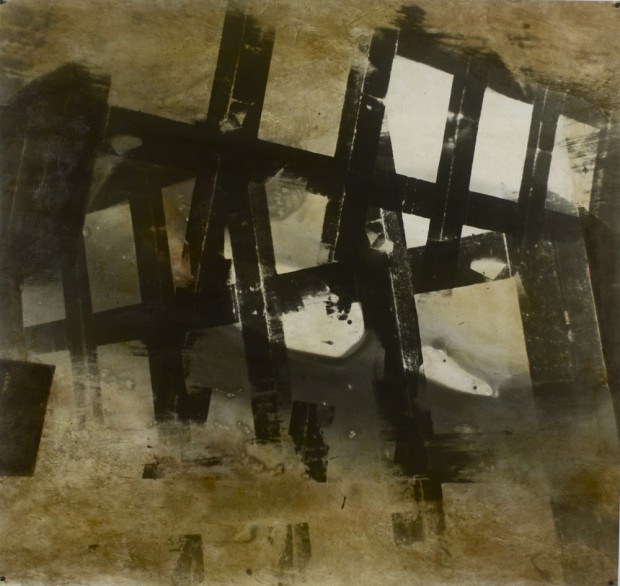Obsure Places
Stefan Kiess
Fotografische Arbeiten
Eröffnung: Samstag 20. Juni, 18 bis 21 Uhr
Dauer der Ausstellung bis 31. Juli 2015
Triennale der Photographie 2015
Führung mit dem künstlerischen Leiter der Triennale, Krzysztof Candrowicz,
20. Juni, 11 bis 14 Uhr durch die Galerien im Kontorhausviertel.
Info und Anmeldung unter galerie@hengevossduerkop.de (Teilnahmegebühr: 15 € p.P.)
Die fotografischen Arbeiten von Stefan Kiess sind keine Fotografien – sie sind aus Fotografien gemacht. In einem komplexen Montageverfahren werden Negative zerschnitten, umkopiert, zusammengesetzt, wieder zerlegt, umkopiert u.s.w., sodass schließlich weder Ur- noch Abbilder zu erkennen sind. Der Titel der Ausstellung „obscure places“ nimmt auf die seltsam vertraut / unvertraute Wirkung der entstandenen Bilder Bezug.Die Montage ist, unter anderem, ein Mittel, die Zentralperspektive zu verlassen und damit den Illusionsraum aufzulösen. In einem Prozess der forschenden Annäherung wird dieAuflösung der Gegenständlichkeit so weit getrieben, daß die Struktur des fotografischen Materials selbst hervortritt. Materialstruktur und Oberflächenanmutungen schwingen mit- und Gegeneinander. Es entstehen Formüberlagerungen. Binnen- und Außenform, positive und negative Formen durchdringen sich, verwandeln sich ineinander.
In diesem Sinne befassen sich die Arbeiten von Stefan Kiess mit dem Repertoire architektonischer Formensprache, aber auch dem bildnerischen Kanon der Abstraktion, um autonome Formen zu entwickeln. Ob das fertige Motiv – meist als Teil einer Reihe oder Serie konzipiert – dabei kleinformatig oder in monumentalem Maßstab reproduziert wird, ist – so der Künstler – eine Frage der Angemessenheit im Verhältnis zur Bildaussage. In der Ausstellung zeigen wir größere Formate. In „Obscure places“ klingt das Thema der vorangehenden Serie „Auslöschung“ nach, die Urthemen der Architektur durchdeklinierte: die bergende Höhle und der Schutzraum, das Sicherheitsbedürfnis des Menschen. Dabei werden auch die Gegenthemen Teil der Arbeit. Der Schutzraum ist nur das Gegenbild des Ausgeliefertseins. Und ähnlich verwandelte der Künstler in der Serie „Finis Terrae“ die dialektische Widersprüchlichkeit des menschlichen Daseins in Bildmetaphern: die sprichwörtlichen Ruinen des Fortschritts, die im Zuge von Industrialisierung, Kolonialisierung oder Krieg entstanden sind. Nie ging es Stefan Kiess darum, Bildbeispiele in einem seriell-dokumentarischen Verfahren (Stichwort: Bernd und Hilla Becher) zu dokumentieren, sondern mit eigenständigen Formengebilden die Zweischneidigkeit der Moderne zu spiegeln. Aus fotografischem Material werden im oben beschriebenen Montageprozeß abstrakte Bildmetaphern hervorgebracht. In „obscure places“ bekommen die Formenkombinationen, Atmosphären und grafischen Effekte eine bisher selten in seinem Werk erreichte Verdichtung.
Nach dem Studium der Visuellen Kommunikation und des Foto-Design in Schw. Gmündund Dortmund ( 1974 – 1981 ), arbeitete Stefan Kiess 18 Jahre als freier Architektur – und Industriefotograf. Seit Anfang der 2000 widmet er sich ausschliesslich künstlerischen Projekten. Er lebt und arbeitet in Köln.
Weitere Informationen über die Galerie.
Stefan Kiess’s photographic works are not strictly photographs, but they are composed of photographic images. In complex montage procedures, the artist cuts up negatives, reduplicating, reassembling, disassembling, and again reduplicating these in a multi-stage procedure that ultimately renders the original images and replicas indistinguishable. The title of the exhibition Obscure Places makes reference to the strangely familiar/unfamiliar effect of the resulting images. Among other things, montage serves as a medium to depart from the central perspective and to eliminate the illusionary space. In a process of investigatory approximation, the representation is successively dissolved until the structure of the photographic material itself becomes evident. The material structure and surface appearances both interact with and counter each another, while superimpositions of inner and outer, positive and negative forms mutually interpenetrate and transform one another. In this sense, Kiess’s works address the repertoire of architecture’s formal language, but also the pictorial canon of abstraction, while developing autonomous forms proceeding from these points of departure. The artist’s decision to reproduce the motifs resulting from his complex aesthetic transmogrifications, which are usually conceived as part of a series, in small formats or in a monumental scale is based upon finding the adequate balance of stylistic aspects in relation to the aesthetic content. In the exhibition, we are presenting framed larger formats.
In Obscure Places, the theme of the artist’s previous series, Auslöschung, (Obliteration) is still resonant, which revolved around fundamentals of architecture: the protective space of the cave, the shelter, and the human need for safety and security. In the process, the related antitheses became part of the work. The shelter or haven was made manifest as the counter-image of helplessness and subjection. In the series Finis Terrae, the artist transformed the dialectical contradictoriness of human existence into pictorial metaphors in a similar manner, pointing to the proverbial ruins of progress, which came about in the course of industrialization, colonization, or war. It has never been Kiess’s objective, however, to document phenomena in an exemplary fashion employing a serial, documentary method (in the manner of Bernd und Hilla Becher, for instance), but rather to reflect the double-edgedness of Modernism with his own unique formal creations. In the montage technique outlined above, he brings forth abstract pictorial metaphors from the photographic source material. In Obscure Places, the artist succeeds in an exceptional compression and conflation of formal combinations, moods, and graphic effects that marks a new level of accomplishment in his work.
After completing his studies of visual communication and photo design in Schwäbisch Gmünd and Dortmund (1974 – 1981), Stefan Kiess worked as a freelance architectural and industrial photographer for eighteen years. Since early 2000 he has been exclusively engaged in realizing projects as an independent artist. He lives and works in Cologne.
For further information please contact the gallery.

